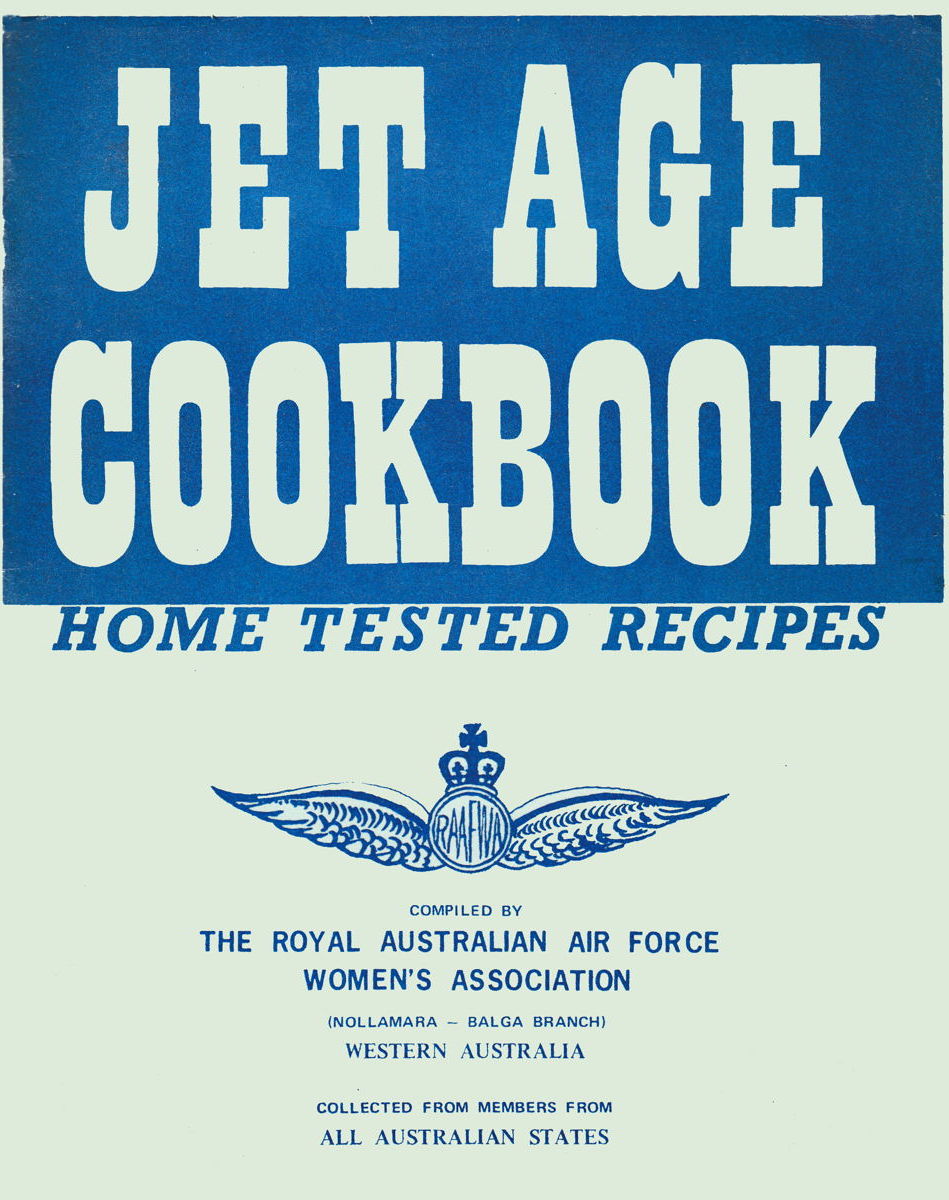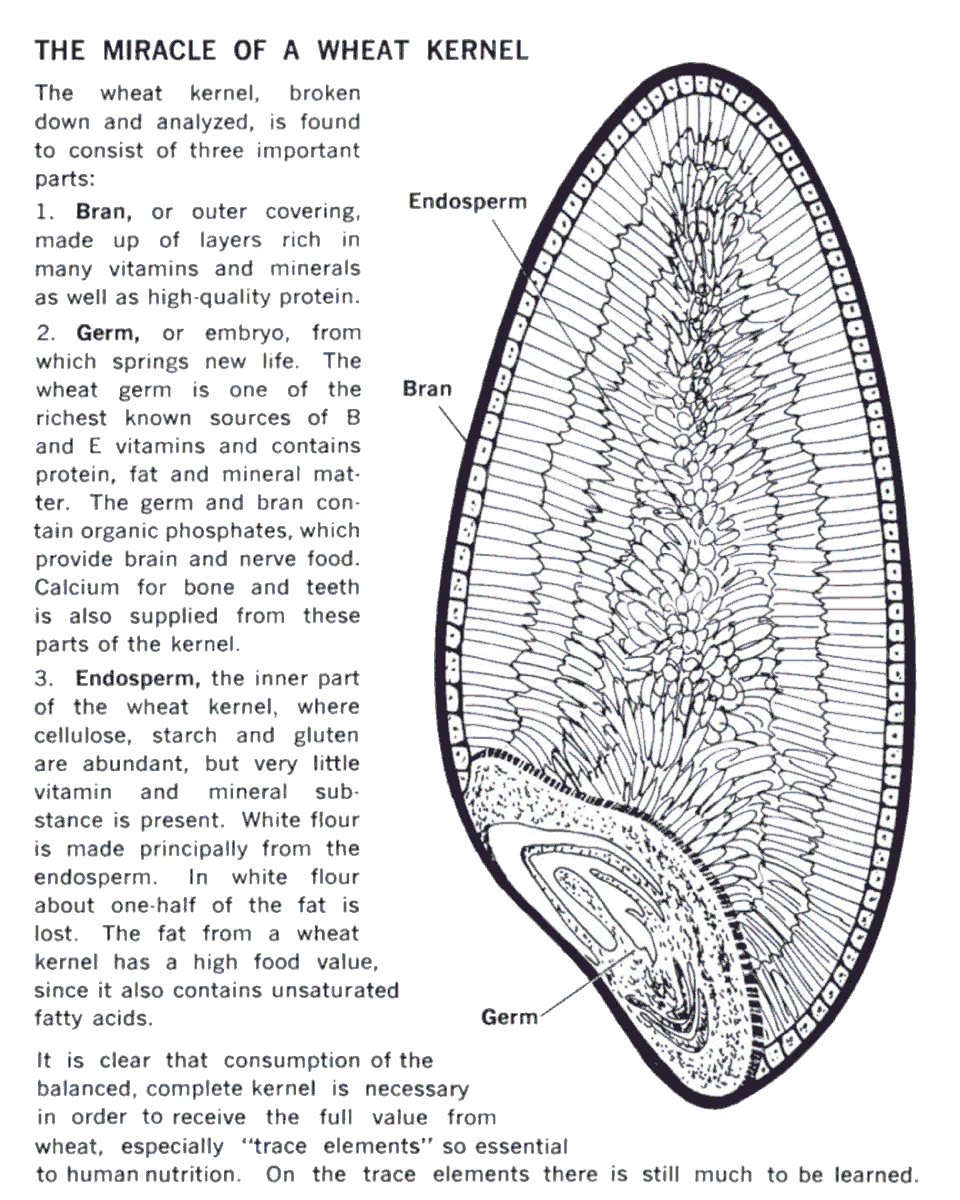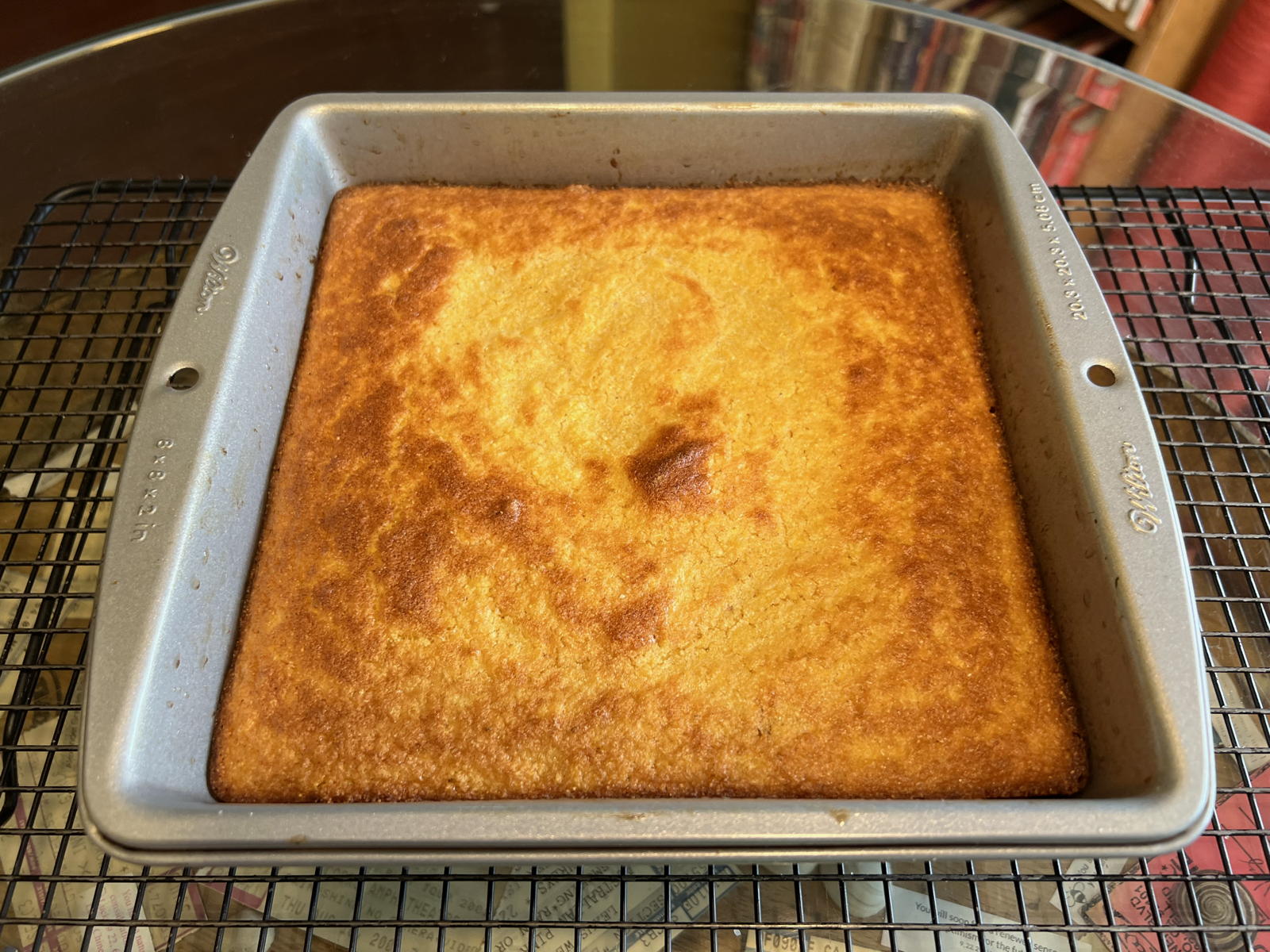- Christopher Ludwick, American Patriot and Baker—Friday, December 12th, 2025
-
“Christopher Ludwick was a true hero of the American Revolution. A German immigrant, he made his fortune in part by baking gingerbread in Philadelphia, and then used his baking knowledge, patriotic spirit, and all of his fortune to aid the American cause.”
Contributions to the 2026 Semiquincentennial are beginning to appear. Max Miller here accompanies a 1773 gingerbread with a short history of the amazingly patriotic baker Christopher Ludwick. He served under Washington both as a military baker and as a spy.
Max Miller: Gingerbread for Washington’s Army at Tasting History with Max Miller (#)
- Using search engines to guess cookbook years—Wednesday, November 19th, 2025
-
Community cookbooks are notorious for not including any indication of when they were printed. I’ve just published a list of cookbooks on the Padgett Sunday Supper Club where I’ve had to guess at the year. This is both to help others who might have the same cookbook and wonder when it was made, and in the hope that someone may remember when the book was published either because they’re in it or an ancestor was in it—or they were part of the organization that published it. If you’re among the latter, please write!
This list should automatically update. Whenever I’ve had to guess what year a book was published, that book should automatically show up in the list.
Many people attempt to use graphic design clues as a guide to a cookbook’s date. I see Glen Powell do this all the time, for example, and while I understand that his extensive experience gives him a better sense than I about the relationship between era and design, I never trust that kind of estimate. Changes in style can take decades to completely spread across North America and the United Kingdom. There were some people still typing their cookbooks well into the seventies and the eighties, and others producing what appear to be quality, modern finished products as early as the thirties.
I have an Australian community cookbook, for example, that looks to me like it was from the fifties, maybe early sixties, and possibly even earlier. The graphic style, the writing style, even the measurements and oven “temperatures”, all scream mid-twentieth century. But it has advertisements from businesses that weren’t in business at their advertised location until 1969. From the advertisements, I’m dating that book between 1969 and 1976.
Reprints can also cause problems with dating. I have a Pennsylvania Dutch cookbook from Culinary Arts Press that lists itself as being from 1936; I am nearly certain it’s a facsimile reprint, but it might not be. Culinary Arts Press is one of those organizations that was often ahead of its time in graphic design—and then kept using a similar design aesthetic well into the fifties. Of course, if it is a reprint, I have no idea when it was reprinted. I can only hope that it’s a facsimile reprint so that the date of 1936 at least can be reasonably applied to the recipes.
In this business, you never really know.
- Graham bread in the crockpot—Wednesday, October 22nd, 2025
-
I was wandering through an antique store in Corning, Arkansas, when I ran across this marvelous manual for what I think is the original Rival Crock•Pot. The pamphlet is sadly not dated, not even with the year-like code that later Crock•Pot manuals would sport on the back cover. However, Rival’s version of the slow cooker was introduced in 1971.
What struck me about this particular printing of the pamphlet, however, is that it contained instructions for a “special Bread 'n Cake Bake pan”.
Our Bread ‘n Cake Bake pan makes a miniature oven of your Crock-Pot! It’s custom designed for marvelous, easy baking of cakes, breads, casseroles or baked potatoes… right in the Crock-Pot… Homemade breads give off that oldtime aroma and have that hearty taste. If you like yeast breads, the “batter” way is the better way. There’s no need to knead… and little waiting for dough to rise.
I of course immediately went to my usual vintage haunts looking for the “Bread ’n Cake Bake” and found one in great shape. It may have been easier nowadays than finding a two-pound coffee can suitable for baking. If you do want to go the full vintage route and use a coffee-style can, you might be able to use a not-quite-one-pound Cafe du Monde can, or a not-quite-two pound beans or tomatoes can.
To top it all off, the very first recipe for homemade bread in the Bread ’n Cake Bake section of this manual was for a graham flour bread. Grandma’s “Dark” Bread incorporates “½ cup whole wheat or graham flour” into the dough. I’ve been experimenting with graham flour this year, so it seemed the perfect place to start.
It was so good, I haven’t made any of the other breads in this section yet.
Graham flour is not readily available today. Most recipes—even this one—suggest using either graham flour or whole wheat flour. However, whole wheat flour is not quite the same thing. Graham flour is literally the whole flour. Whole wheat flour is more of the flour than white flour, but not the whole flour.
white flour endosperm whole wheat flour endosperm and bran graham flour endosperm, germ, and bran - Pumpkin cornbread—Wednesday, October 8th, 2025
-
This is a very easy cornbread and a very easy use for pumpkin parts. There is no boiling or baking the pumpkin to prep it before using it. Just grate it like carrots. This recipe is in fact a slight modification of a carrot cornbread recipe from the El Molino Best cookbook. El Molino is itself a great cookbook with a great California-style cornbread.
I included the El Molino cornbread in my own Traveling Man’s Cookery. It’s a relatively sweet cornbread because, while it contains very little added sugar, carrots themselves contain quite a bit of sugar. It’s why some people choose to make carrot pie instead of pumpkin pie: it means less processed sugar. I’m not in that camp, but I do like the sweetness that carrots add to cornbread.
Pumpkins are not nearly as sweet as carrots, so this Halloween version is not nearly as sweet a cornbread. I switched out the brown sugar for molasses—preferably, sorghum molasses—to give what sweetness there is in the bread a hint of autumn.
Another syrup that ought to be great with pumpkin and cornmeal is maple syrup. So if you don’t have a source for sorghum molasses, or just don’t like it, consider trying maple. As a last resort, brown sugar will be fine, too. Brown sugar has molasses in it. Depending on the manufacturer, brown sugar is either sugar before the molasses has been (completely) removed, or white sugar with molasses added back in.
Serendipitously the color of pumpkin is much like the color of carrots. The orange in each case combines very pleasingly with the yellow of cornmeal. But given that foods as different as carrots and pumpkin taste great in this recipe, you could probably use any squash or root vegetable that you enjoy.
Zucchini would be the canonical choice in the area I grew up. I suspect it would produce a more green cornbread. You might even play that up by adding some herbs. Whatever herbs you enjoy with zucchini ought to be great in zucchini cornbread.
- Whitegate Garlic Potatoes for National Potato Day—Wednesday, August 6th, 2025
-
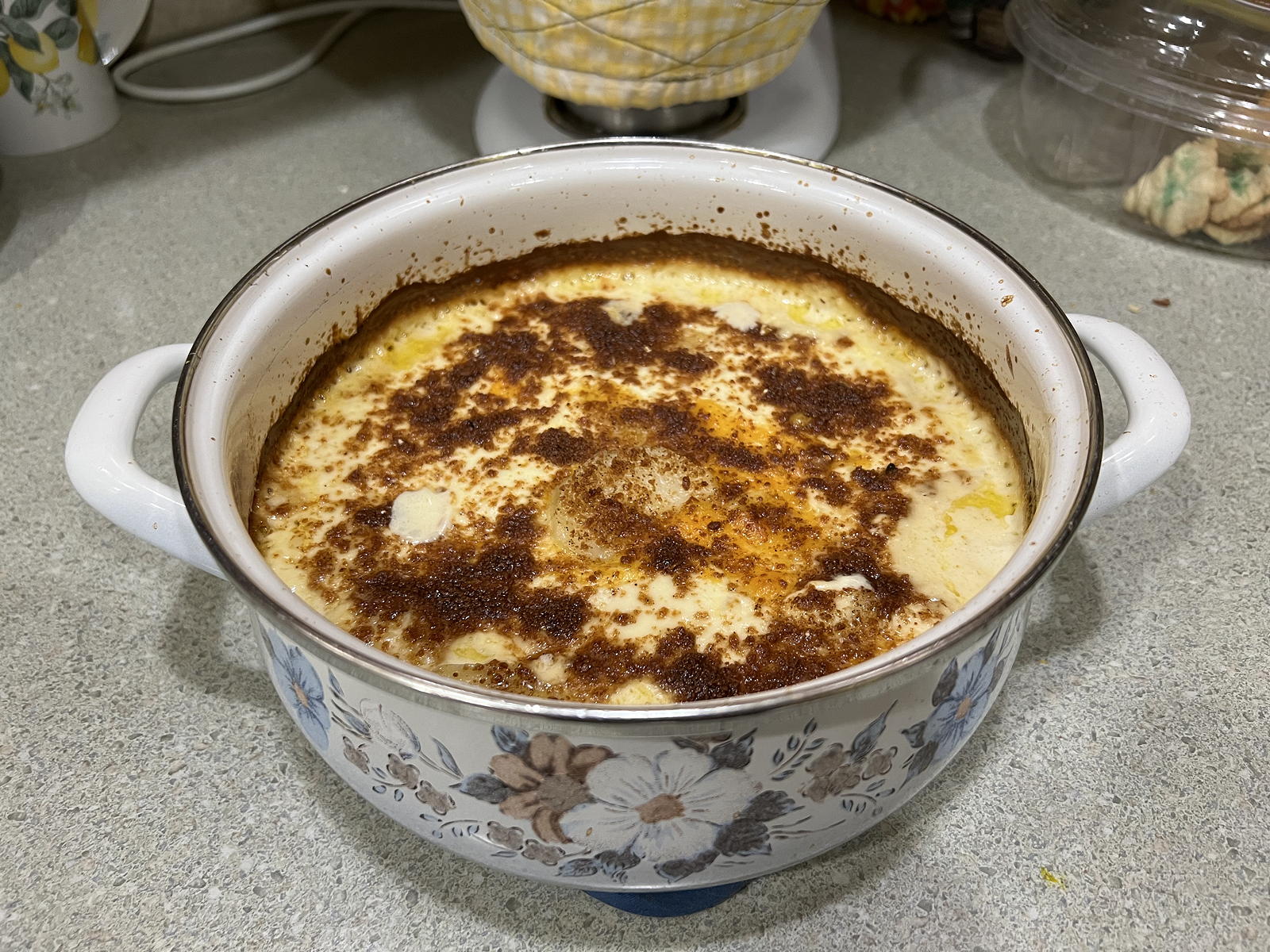
Beautiful potato casserole for any holiday or gathering!
National Potato Day is two weeks away, on Tuesday, August 19. This year, I’m going to the source. If you’re going to make pasta, you go to the Italians. And if you’re going to make potatoes, you go to the Irish. Many years ago, some friends gave me a copy of In Good Taste, a cook book from the Irish Countrywomen’s Association.
Our game group met the day after Saint Patrick’s Day a few years ago, and so we did a Saint Patrick’s Day theme for the food. I made these garlic potatoes. The other dishes were Irish coddle and corned beef hash. So, apropos of Monty Python, we had potatoes, potatoes, and potatoes.
It was good. “The holy trinity” as one of the friends who gave me the book said when I described the recipe to them. It was so good that I made it again for Christmas with family the same year, which is where the photos come from.
These potatoes need to be sliced thin. A knife is fine, but it will help to have a mandoline (which I used) or a food processor with a thin slicing attachment. When they’re done, the potatoes must be almost as tender as mashed.
I call them “Whitegate Garlic Potatoes” because Peggy Bowler, who submitted them to the Irish Countrywomen’s Association cookbook, called them “Garlic Potatoes”. And she’s from the Whitegate Guild of the organization.
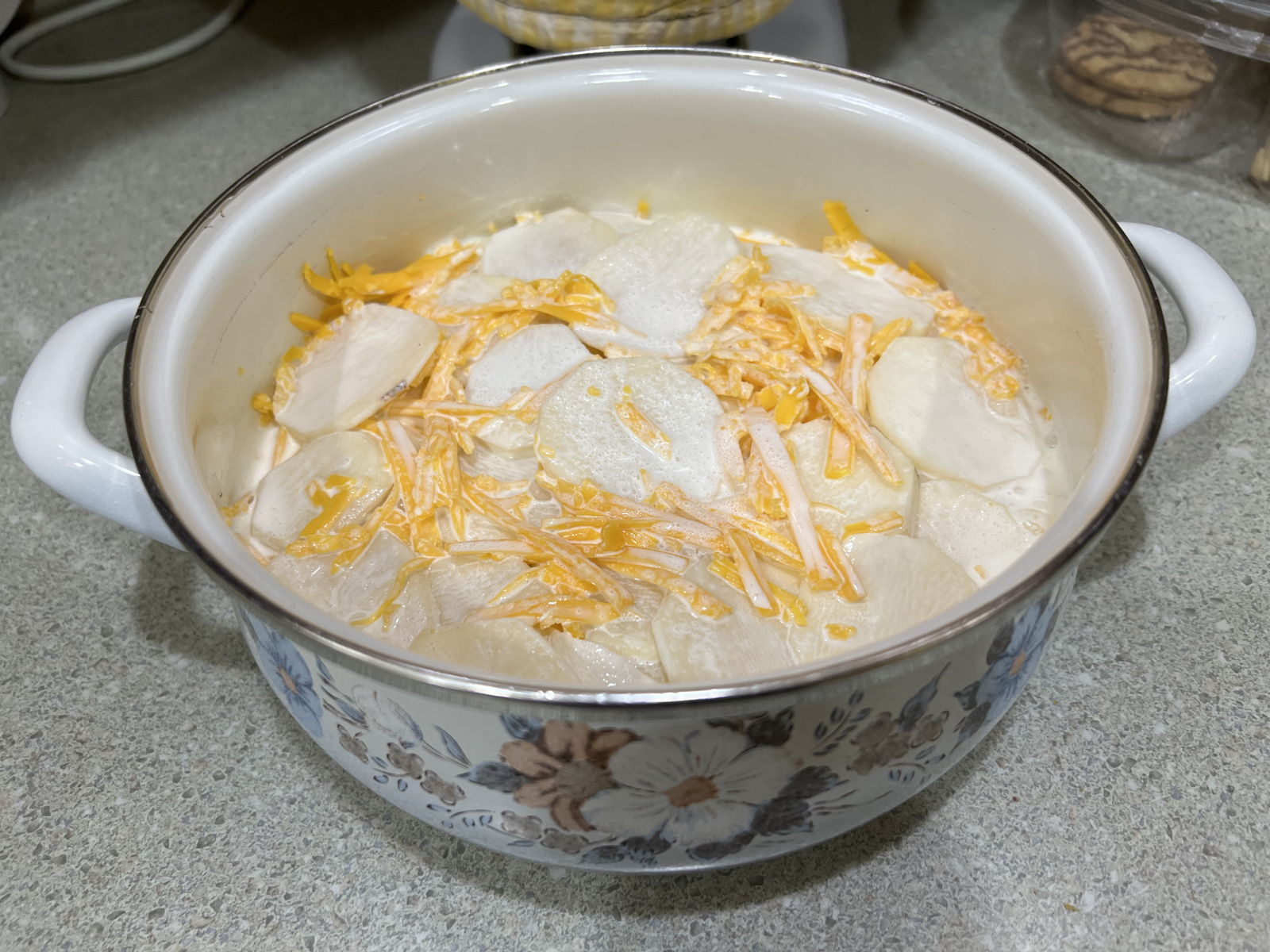
The unbaked potatoes, covered in cream, waiting for the oven.
And Holy Saint Patrick, Batman, are these good.
Looking on the recipe now, I realize I used slightly less milk and cream as the recipe calls for. It calls for a quarter pint of milk and a carton of cream. Assuming that a carton of cream is a pint, that’s four ounces of milk and sixteen ounces of cream.
Except that these are imperial measurements. Their pints are about 20% larger than ours. So if you want to go full Irish, do about 4.8 ounces of milk and 19.2 ounces of cream.
Obviously, it helps to have a digital scale.
- The cookie dough manifesto and the harridans of safety—Wednesday, July 2nd, 2025
-

I follow Seasoned Advice on the Stack Exchange network, and find it invaluable for questions about vintage cooking. However, it is also occasionally very disheartening. The feed is filled with questions like The minced meat fell down the ground! Is it safe?
Well, if you eat it raw, it probably isn’t. That has nothing to do with whether it fell on the ground or not. But it’s hard to blame people for worrying over—almost literally—spilt milk when you’ve got a news media and fear culture that feeds off of such fears and creates as much fear as it can, even—especially—where joy and laughter abound.
Back in December, for example, a group of scientists “found” that bacteria transfer takes place very quickly, “thus debunking the five-second rule once and for all.”
It’s the sort of experiment only an autist who doesn’t understand people could perform, and only a finger nanny opposed to all fun could promote. It debunks absolutely nothing, because it completely misunderstands what it means when someone invokes the five-second rule. The five-second rule (or ten-second rule, or whatever) is a joke with a very serious meaning. No one believes that if you drop something on the floor it’s not going to be contaminated as long as you pick it up within five seconds. That isn’t what the five-second rule is about.

Okay, maybe not this floor. (For the record, I enjoy black licorice, or anything flavored with aniseed.)
If you drop a favorite food on the floor, those five seconds stretch forever. No sane person will throw out their favorite cookie because it fell on a clean dining room floor. If you drop a disliked food, on the other hand, those five seconds pass within a nanosecond.
“Whoops! Can’t eat that black licorice. It fell right into the garbage can, all on its own!”
The five-second rule is a recognition that life comes before safety. The decision to eat comes before the invocation of the rule. The rule is a joke, invoked regardless of how long the item has been on the floor once the decision has been made. It’s a recognition that everything is contaminated, and the question of whether to eat it is a compromise between how contaminated it is and how enjoyable it is.
It’s all a tradeoff.
- A Vicennial Meal for the Sestercentennial—Wednesday, June 25th, 2025
-

The American Cookery reprint sold by Townsends is by far the most readable I’ve seen.
As we move toward America’s Sestercentennial next year—or Semiquincentennial, as it looks like it will officially be called—it’s time to go back to the beginning. In previous years I’ve covered cookbooks from 1976 celebrating the Bicentennnial, and cookbooks from 1876 celebrating the Centennial.
- Bicentennial meal
- Centennial Meal
- Vicennial Meal ⬅︎
- Sestercentennial Cookery
There were no cookbooks in year zero, 1776, celebrating the American Declaration of Independence, for two obvious reasons. The glib answer is that we were too busy fighting for that Independence to waste time writing a cookbook celebrating Independence.
The second reason is that, until we declared our independence we weren’t American. We were British, and our cookbooks were British. Our cookbooks remained British, with likely a smattering from France and Italy among those literate in those languages, even after the war.
Now, it isn’t entirely obvious that there would be no cookbooks celebrating the fight for independence in 1776. There was a homespun movement leading up to the Declaration. It isn’t just conceivable, it’s very likely, that someone had the idea of emulating the homespun movement in cooking. If anyone did, however, there is no known record of it. It’s likely that if any such effort existed it was passed by letter from household to household and never collected into a single work.
- Mom’s High School Cooking Notebook, 1960—Wednesday, May 7th, 2025
-
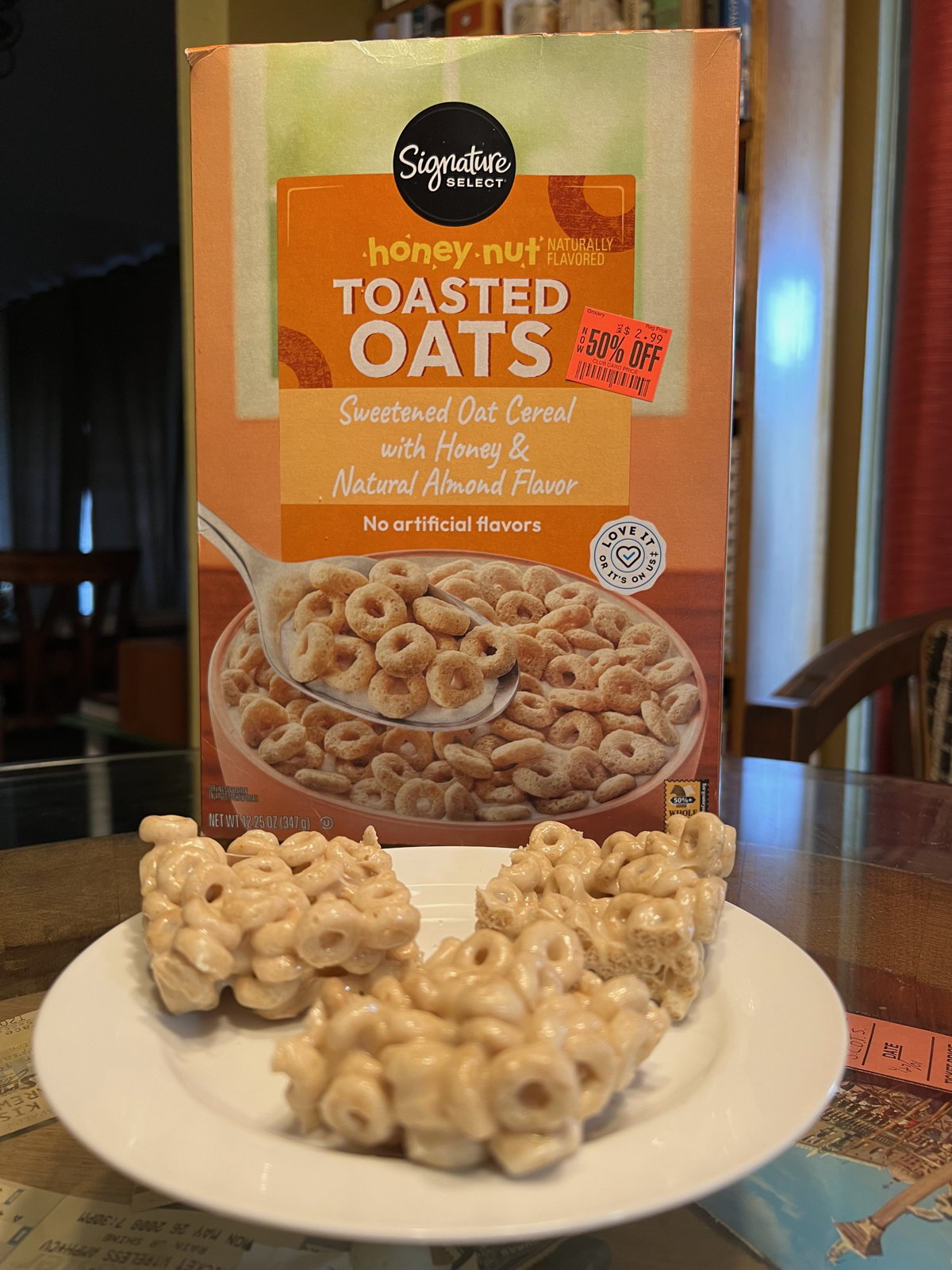
Mom would be proud: not only is it a less expensive brand, it’s knocked down even from that!
I’ve made some great old cookbooks available under The Padgett Sunday Supper Club banner, as well as one or two not-so-great cookbooks. Today’s is very close to my heart as we approach Mother’s Day on Sunday. For my entire life until she died, my mother has had this red-covered folder (PDF File, 7.1 MB). It was from her home economics class, or whatever it would have been called circa 1960, in high school.
When dealing with vintage recipes, people commonly talk about our lack of knowledge about what the intended audience for those recipes knew. Recipe authors and recipe readers assumed a common understanding that we, fifty or more years later, necessarily lack.
This bit of ephemera from the cusp between the fifties and sixties provides some insight into how some, at least, of that shared knowledge was acquired in that period. As other vintage writers can tell you—Glen Powell, for example—the kinds of background knowledge that recipes assume change over time. The background knowledge that people had during the era of wood ovens will be very different from the era of gas ovens and then electric ovens.
Except for the rice krispy candy I don’t remember any of these dishes, and I don’t know for sure that she even used that recipe instead of the one on the back of most marshmallow bags. These aren’t the classic foods I remember mom making when I was young. What they are, are the recipes that trained her to make those foods.
I do know that mom often had the notebook out when preparing for a potluck or a luncheon. I suspect she was making biscuits, or consulting the measurement equivalents. Those are the pages that look most worn. The rice krispy candy page is very worn. She may also have been using the cherry pie filling recipe for any fruit, judging from its stains. We had pie a lot, but it was rarely cherry pie.
That said, I certainly don’t remember cottage cheese coleslaw, and that’s one of the most stained pages of all.


Mimsy Were the Borogoves
Food: Recipes, cookbook reviews, food notes, and restaurant reviews. Unless otherwise noted, I have personally tried each recipe that gets its own page, but not necessarily recipes listed as part of a cookbook review.
